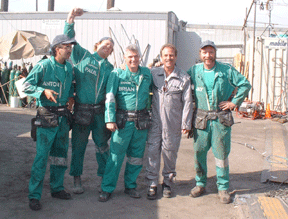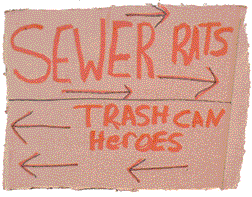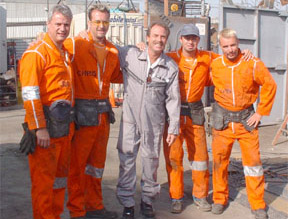
 |
 |
 |
Shown in the photos above are the two teams. Both photos include Gale Holsman, president of Kansas City's American Sweeping, Inc., who was the judge for the event. Brian Giles, Elgin's team expert is shown in the middle of the Trash Can Heroes photo, and Jim Adair, Schwarze's team expert, is on the left side in the Sewer Rats photo.
An Introduction to Junkyard Wars
by Ranger Kidwell-Ross
 At some time or other, many sweeper operators have no doubt wished they could have a crack at building a sweeper of their own. Well, how about this for a dream come true: Imagine that someone will sponsor you and a couple of your friends to just such an opportunity, all expenses paid. "What," you say, "surely there must be a catch!" Well, yes, actually there are several...
At some time or other, many sweeper operators have no doubt wished they could have a crack at building a sweeper of their own. Well, how about this for a dream come true: Imagine that someone will sponsor you and a couple of your friends to just such an opportunity, all expenses paid. "What," you say, "surely there must be a catch!" Well, yes, actually there are several...
In this case, until minutes before starting on their project the three team members don't have a clue about what they'll be building. Secondly, they have to make the entire machine out of scrap parts they can scavenge from a wrecking yard, and they only have 10 hours to complete your finished product so it can compete against the sweeper built by another team. Oh, and there are multiple cameramen following every move, sometimes stopping the action to request re-takes of particular segments.
That's the premise for Junkyard Wars, a popular show offered by The Learning Channel. On the series, two teams made up of 3 people each vie for who can build the best operating machine over the course of just one day. The sweeper segment you'll be reading about was first shown on June 12th, 2002, and will continue to be re-broadcast periodically over time. As someone who watched the building and testing process firsthand, as well as who saw the show itself, I can attest that this episode is a 'can't miss' for anyone in the sweeping industry.
 The show was taped on location in the show's private junkyard near Hollywood, California. Fortunately for the two teams, each is assigned a team member who is an expert in the manufacturing process of whatever type of machine is being made for that particular show. In this case the experts were, appropriately, from arch-rival sweeper manufacturing companies Elgin and Schwarze Industries.
The show was taped on location in the show's private junkyard near Hollywood, California. Fortunately for the two teams, each is assigned a team member who is an expert in the manufacturing process of whatever type of machine is being made for that particular show. In this case the experts were, appropriately, from arch-rival sweeper manufacturing companies Elgin and Schwarze Industries.
Jim Adair, Schwarze's vice president, coached a team made up of workers from Boise, Idaho's wastewater treatment plant. They called themselves 'The Sewer Rats.' Brian Giles, from Elgin's quality control department, headed up the rival 'Trash Can Heroes' team, which was made up of men who build custom bicycles in the San Francisco area. To get on the show, each of the teams had submitted detailed applications, as well as a video showing the skills of the various members.
The judge and commentator for the event was a man known throughout the sweeping industry as 'The Sweepin' Preacher,' Gale Holsman, sweeping consultant and president of Kansas City-based American Sweeping, Inc. Mark Carter, of local sweeping company, Bill's Sweeping, was also on hand as a consultant to the show (and to pick up all the leftover trash with one of his sweepers after the competition the final day).
 Members of the two teams had no idea what they'd be building until the day the show was taped. Then, after basic instructions in safety and tool usage, at about 10am the teams were told what they'd be building. Then, almost immediately the production of the show -- and the beginning of the war -- got underway. After only a few minutes of individualized instruction from their coaches on what to scavenge and what they'd be trying to build, the starting horn sounded.
Members of the two teams had no idea what they'd be building until the day the show was taped. Then, after basic instructions in safety and tool usage, at about 10am the teams were told what they'd be building. Then, almost immediately the production of the show -- and the beginning of the war -- got underway. After only a few minutes of individualized instruction from their coaches on what to scavenge and what they'd be trying to build, the starting horn sounded.
Two members from each team took off into the junkyard to look for parts and materials, while the expert and team captain from each team had to remain in the production area. Oh, and did I mention it was hot, in at least the upper 90's? Or that everyone wore fireproof jumpsuits for safety and so they'd look good for television? Those factors became increasingly important as the day wore on.
Scavenged parts were brought into each team's corral-like area. The teams' respective work areas were separated by a wall, designed such that the teams couldn't see what each other were doing yet the design afforded the production crew an ongoing view of both. Each team's working space was outfitted with enough tools to make a machine shop owner's eyes roll up in his head, from high-tech cutters to wirefeed welders. The scavenging and building process went on throughout the day and into the night, with only a one-hour break for lunch. Even though it looked impossible that either team could come up with a usable machine in the allotted timeframe, both teams ended up with a working sweeper model by the time the final horn sounded. As pre-ordained, one type was a mechanical broom sweeper and the other was air/vacuum-based.
The following day was devoted to safety checks of the machines by inhouse engineers, to make sure there wouldn't be an accident the next day when testing took place. Testing, which consisted of 3 timed rounds to see which machine could pick up a particular assortment of material, was extremely close. A wide variety of material was put down on about a 1/4-mile, circular track. This included vegetables such as cabbage and celery, to clothing scraps to aluminum cans, sticks and branches and much more. The competition was extremely close throughout and, yes, there was, in the end, a clear winner.
Go to Part 2, From the perspective of Jim Adair, vice president of Schwarze Industries, Inc. and team expert for the Sewer Rats.
© 2005 - 2021 World Sweeper
|
Back to Junkyard Wars HomeBack to Funny BusinessSite Map / Table of Contents |